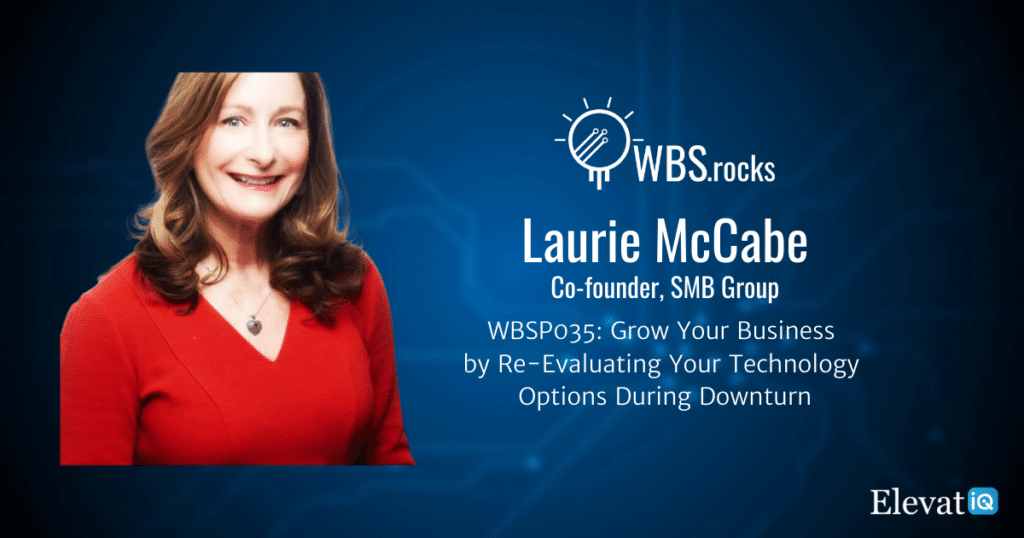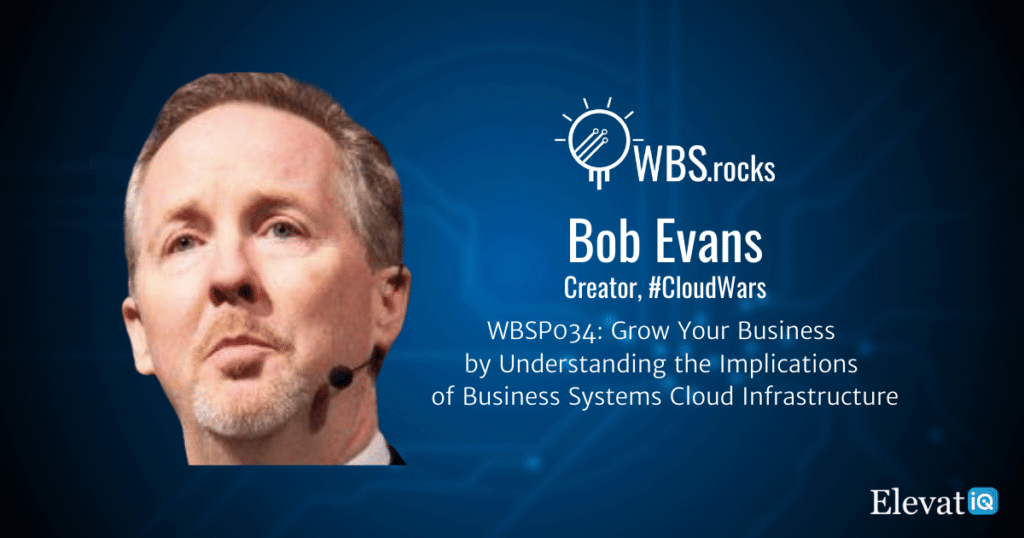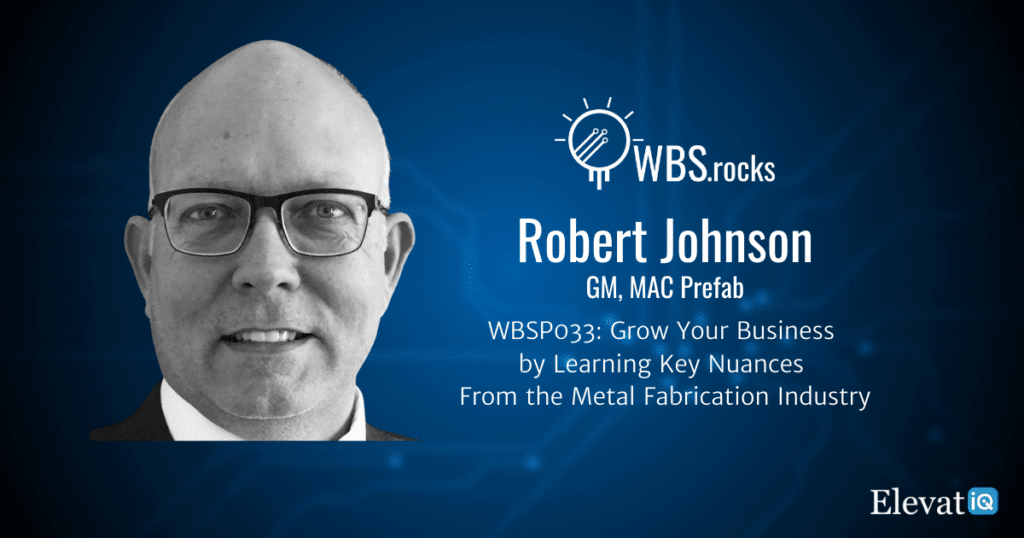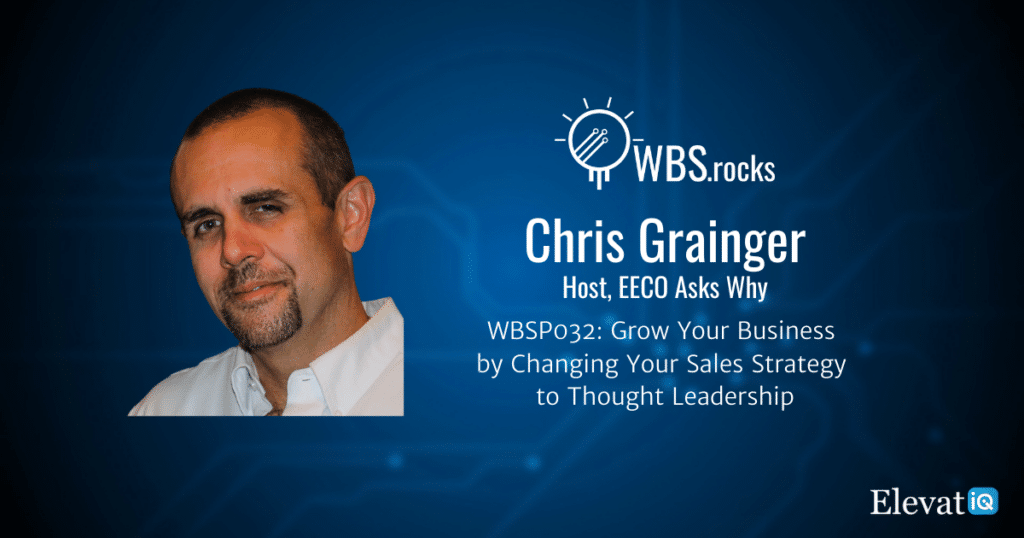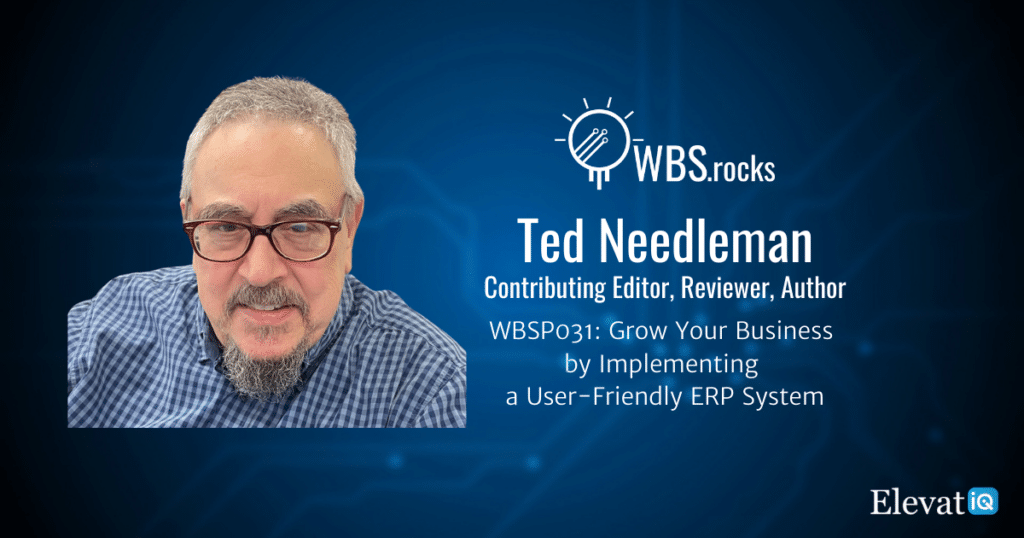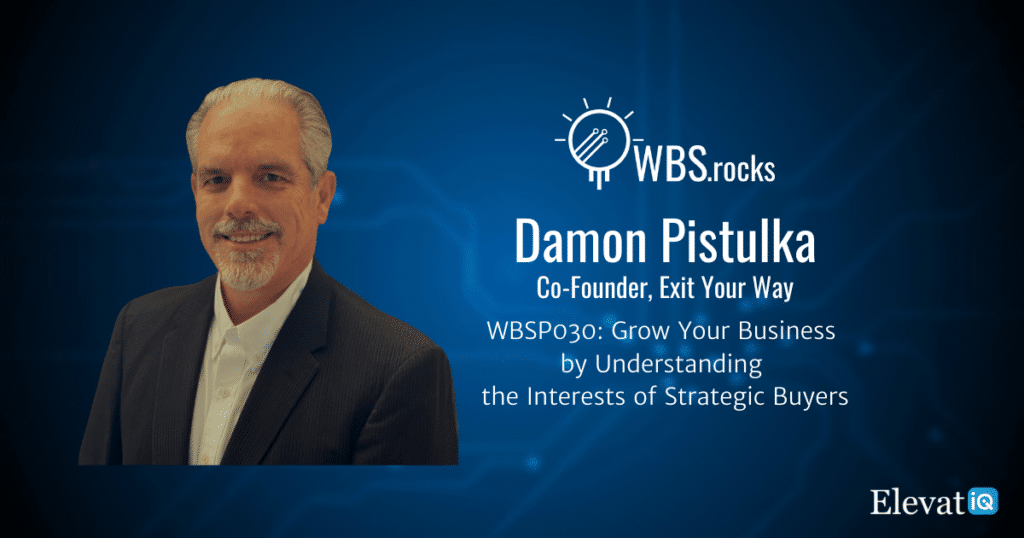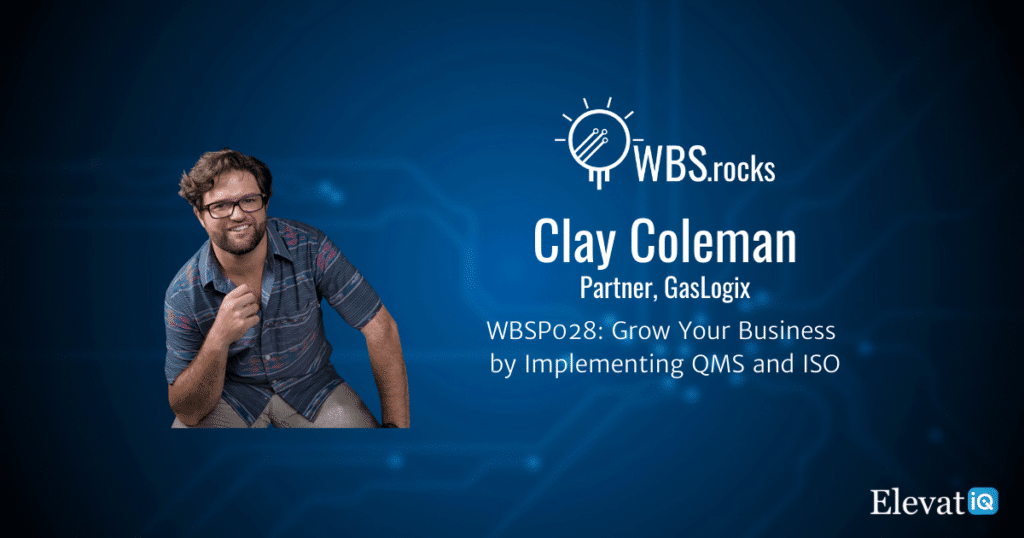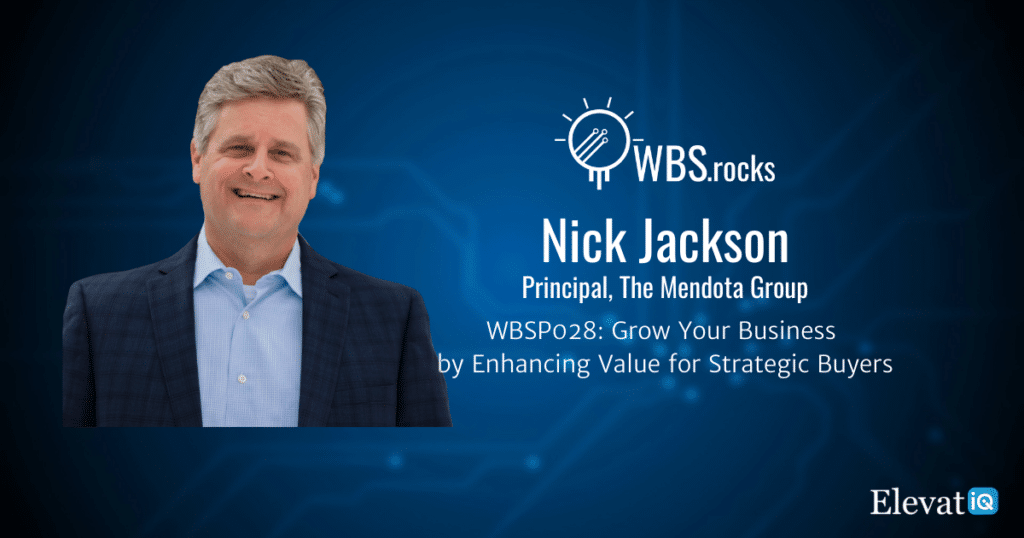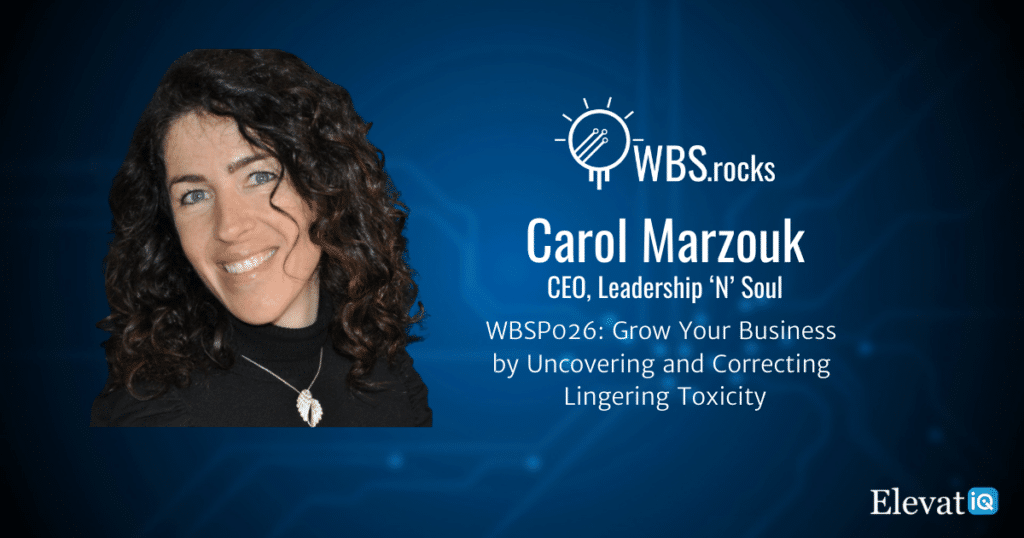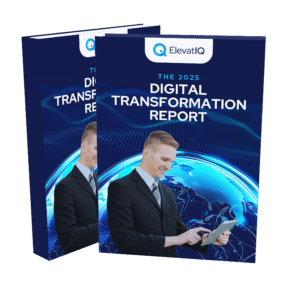WBSP035: Grow Your Business by Re-Evaluating Your Technology Options During Downturn w/ Laurie McCabe
In this episode, we have our guest Laurie McCabe, who discusses how technology can help struggling businesses be more efficient during downturns. She also touches on different technology trends and ERP ecosystems, how they have evolved and what changes you might expect in the future. Finally, she helps SMB business owners understand their technology options.
Chapter Markers
- [0:19] Intro
- [2:33] Personal journey and current focus
- [3:23] Perspective on growth
- [6:06] Difference between automation and digitization
- [9:31] Best predictor of the SMB market
- [13:57] The contradiction between analyst reports for manufacturing from actual sales
- [15:44] How to prepare for uncertainty?
- [22:38] Agility with cloud ERP
- [32:23] Closing thoughts
- [32:57] Outro
Key Takeaways
- If you can’t automate, it’s very tough to scale. And what’s happened during the pandemic is that that’s kind of gone on to steroids. And they’ve realized they have to not only automate but digitize a lot of their business.
- Whether moving tasks from a standalone spreadsheet to more central kind of applications or it’s doing more electronic transactions, more ecommerce, more digital payments, people are realizing that there’s no real time to wait. With this pandemic, the push to digitize has really accelerated.
- Now uncertainty is the keyword of the day. And everybody’s trying to figure out okay, well, I’ve adapted from COVID hit to now, but we don’t know what’s going to come next. In other words, we’re not going to go back to what we had before. We’re not going to stay the way we are now.
- The whole psychology of customers is changing, whether it’s B2B or B2C. What they want to buy is changing, how they want to buy is changing, where they want to buy is changing, and who they want to buy from is changing.
- When you’re using an on-premise kind of ERP, and you want to accommodate growth, what are you going to do is that you have to buy more servers, buy more licenses, install all that manage that. With the cloud, it’s simply a question of increasing your subscription.

Subscribe and Review
Apple | Spotify | Stitcher | Google Podcasts | Deezer | Player FM | Castbox
About Laurie
Laurie brings more than 25 years of experience in the IT industry to her current role as Cofounder & Partner, SMB Group. She has built widespread recognition for her insights into the SMB technology market.
She is a six-time Small Business Influencer Awards winner; has been recognized as one of the 50 Most Influential People in Small Business Marketing by AllBusiness, and is a member of Dun & Bradstreet’s B2B Expert Community. Laurie blogs often at lauriemccabe.com, speaks regularly at industry events and has over 17,000 followers on Twitter.
Resources
Full Transcript
Laurie McCabe 0:00
We’re not going to go back to what we had before. We’re not going to stay the way we are now. So what are things going to look like in six months or 12 months? And we can all make some guesses. Some of them will be better than others. But no one really knows what’s going to happen.
Intro 0:19
Growing a business requires a holistic approach that extends beyond sales and marketing. This approach needs alignment among people, processes, and technologies. So if you’re a business owner, operations, or finance leader looking to learn growth strategies from your peers and competitors, you’re tuned into the right podcast. Welcome to the WBS podcast, where scalable growth using business systems is our number one priority. Now, here is your host, Sam Gupta.
Sam Gupta 0:55
Hello, everyone. Welcome back to another episode of The WBS podcast. I’m Sam Gupta, your host, and principal consultant at this transformation consulting firm, ElevatIQ.
Why should SMB companies be investing in technology during the downturns such as COVID? What could be some of the low-hanging fruits for executives to consider during the downturn? Why investing in technology is a wise idea during the downtrend? These are some of the questions you will have if you are managing a business during COVID.
In today’s episode, we have our guest, Laurie McCabe, who discusses how technology can help struggling businesses be more efficient during downturns. She also touches on different technology trends and the ERP ecosystems, how they have evolved and what changes you might expect in the future. Finally, she helps SME business owners understand their technology options. Let me introduce Laurie to you.
Sam Gupta 1:49
Laurie brings more than 25 years of experience in the IT industry to her current role as Cofounder & Partner, SMB Group. She has built widespread recognition for her insights in the SMB technology market.
She is a six-time Small Business Influencer Awards winner; has been recognized as one of the 50 Most Influential People in Small Business Marketing by AllBusiness, and is a member of Dun & Bradstreet’s B2B Expert Community. Laurie blogs often at lauriemccabe.com, speaks regularly at industry events and has over 17,000 followers on Twitter. With that, let’s get to the conversation. Hey, Laurie, welcome to the show.
Laurie McCabe 2:30
Hey, thanks for having me today, Sam.
Sam Gupta 2:33
It’s my pleasure. Do you want to start with your personal story and your current focus?
Laurie McCabe 2:40
Sure, yeah. Well, I’m basically right now, what I am is the co-founder and partner of a company called SMB group and SMB group, we’re an analyst and research company, and we really look at technology trends in the small and medium business space and try to understand what their challenges are, their goals are and how they want to use technology to help grow their businesses. And I’ve been an analyst and researcher for about 25 years now. So, you know, it’s really our niche and what we’re passionate about.
Sam Gupta 3:23
Okay, amazing. So there’s one question that we ask all of our guests, and that is going to be Laurie, what is your perspective on business growth?
Laurie McCabe 3:32
Well, business growth is somebody something almost every business wants to do, probably every business. And then, in fact, we do surveys every year, we ask small, medium businesses, what what are your top goals and often growing the business is number one, they’re really oriented towards expanding, I mean, there are a few businesses that just kind of want to stay as is, and you’re happy with the status quo, but overall, most businesses want to grow.
Laurie McCabe 4:01
And of course, right now, we’ve been in a pretty challenging time with COVID. And we know from surveys we’ve done over the last few months that almost all businesses have been impacted by COVID. Now, some have actually grown during COVID.
But the majority have seen revenues drop and obviously faced a lot of other problems that kind of get in the way of growth such as social distancing and your safety requirements and guidelines and people working from home and things like that. So growth is always a top goal for every business, but it’s been pretty challenging for many right now.
Sam Gupta 4:44
Okay, so when you look at the downturn, what are some of the changes that you are seeing in the market in the mindset and their appetite for technology when you talk to these customers when you do their surveys?
Laurie McCabe 4:55
Well, I think what’s really happened is that the pandemic has come accelerated the shift to automate. So small and medium businesses have known for a long time, or at least the majority have that to really grow the business and be competitive and be relevant, they have to automate. Because if you can’t automate, it’s very tough to scale. And what’s happened during the pandemic is that that’s kind of gone on to steroids. And they’ve realized they have to not only automate but digitize a lot of their business.
So whether that’s moving tasks from a standalone spreadsheet to more central kind of applications, where everybody can kind of see everything at the same time online, or it’s doing more electronic transactions, more ecommerce, more digital payments, whatever these things are, people are realizing that there’s no real-time to wait, that with this pandemic, the push to digital to digitize has really accelerated.
Sam Gupta 6:06
So it’s a very interesting comment that you made about defense or the distinction between automation and digitization. So how would you define the boundary between automation and digitization?
Laurie McCabe 6:18
Well, it depends. I think, for me, it’s all about can you both automate the process, right, and then create a digital output from that process that you can then analyze and act on, and kind of remove a lot of the friction from the process.
So you know, for example, I mean, e-commerce is a great example. I mean, if you’re taking all your orders online, and you’re fulfilling all your orders based on what’s coming into the system online, that whole process of you know, your payment is processed online, you digitize that whole process, you’ve obviously automated it, but you’ve bought, you’re also now collecting all that information digitally.
So then you can look at it, you can analyze it, and you can understand trends and things like that. So I guess that’s kind of where I would distinguish it a little bit.
Sam Gupta 7:13
Okay, so the process of the survey could be very exciting, right? And I’ve done some surveys myself, and oftentimes, we find that the insight that can be from surveys is always surprising. We find a lot of surprises. So tell me a couple of stories that you found very surprising lately, especially during COVID. Did you have any comments there that were like, okay, I just didn’t know this? And this is very compelling for me. So tell me some stories?
Laurie McCabe 7:43
Well, I mean, I don’t know if we had any surprises that, you know, rocked our world, so to speak. But you know, one of the big, big, the most interesting things I thought was in every survey we do every year, we ask them about their top business challenges.
Yeah, we have a list of about 10 or 12 different challenges. And every survey, one of the things that can tick off might be growing revenues, attracting new customers, retaining existing customers, hiring employees, retaining employees, all these things.
But one of the other things we always have on there is on being sustaining my business through uncertainty or dealing with uncertainty and changing market conditions. Now usually, dealing with uncertainty is way down on the list. It’s like number eight, or nine or ten post-COVID.
Laurie McCabe 8:39
Well, number one on both surveys we’ve done: dealing with uncertainty has become the biggest issue for, and I don’t think that’s surprising when you think about it. But it’s just amazing that this is something that usually Yeah, there’s some uncertainty always in the business climate. Now uncertainty is the keyword of the day. And everybody’s trying to figure out okay, well, I’ve adapted from my COVID hit to now, but we don’t know what’s going to come next. In other words, we’re not going to go back to what we had before. We’re not going to stay the way we are now. So what is what are things going to look like in six months or 12 months? And we can all make some guesses, and some of them will be better than others, but no one really knows. But everybody knows they’ve got to be able to adapt.
Sam Gupta 9:31
Okay, so let’s make some guesses here. So tell me your perspective. Because, in my opinion, I guess since you are sitting right there in the market, you are talking to so many different businesses, you are doing surveys, you are the best predictor of the economy of the SMB system market. So tell me, what is going to be your best guess, Laurie?
Laurie McCabe 9:51
Well, I think what most companies do is they have to plan for different scenarios, okay, because there are just too many elements that none of us have. have any control over. So you know, speaking here in the US. Obviously, this virus is surging. We also have a vaccine. We also are short on vaccine supply. And we also have distribution problems. We don’t know about these new variants, how that’s going to affect things.
So when you try to, you know, none of us, not even the most brilliant people in the world, know how that virus is actually going to play out. And obviously, the economic conditions and the business conditions are all going to revolve around that, to a large extent. So I think for most businesses, in terms of the economic outlook, unless you’re selling PPE, or all the supplies that might go with rolling out vaccines or something like that, you kind of realize that you’ve got to kind of prepare for, okay, kind of baseline business where I’m at today, growth in business, when hopefully, the virus, you know, settles down and starts receding, but then what happens if there’s a strain that’s resistant to the vaccine or something like that.
Laurie McCabe 11:06
So I think you have to think about all those things. And what that means is you have to be very agile and flexible. The number one, your workforce, already, we have a lot of people, of course, working in home, and a lot of businesses, thank you, well, how is this gonna play out over the long term?
So one, one thing I can say with a lot of certainties is we’re not going to go back to everybody being in a traditional office, again, it’s not gonna happen. So think about how you can best accommodate a more flexible workforce. What kind of jobs have to be done on-site? What kind of jobs can be done off-site? How do you accommodate and equip your employees, so they can be more productive in any of those environments? And that doesn’t just mean giving them a laptop and Wi-Fi at home means a lot of other things, both at home and in the office. And even as far as the psychology of the employee, right, and the stress of the employee dealing with all this uncertainty.
Laurie McCabe 12:04
So that’s certainly a big one. You know, you’ve got to be continued to be prepared for new requirements. We just had a new administration come in. We’re going to have already we’ve had some new mandates about masks and things like that. I think there’s going to be more that you know, about maybe you can you require your workers to get vaccines, different kinds of things like that, I think you should be thinking about cash reserves are essential if you’re not able to kind of manage your cash reserves.
So you can hang on through what your worst-case scenario is your big trouble. So no, really no use where it’s important to have a really good financial system, you got to know how much cash you have, where you can get cash, what’s liquid in new business, the new round of PPP loans is coming out, but you really have to make sure you’re doing that right. And then finally, we don’t think that anybody’s going to want to go back in time.
So again, the more you can do things through low touch, no touch kind of transactions, whether that’s e-commerce, digital payments, virtual services that you provide, instead of physical world services when that’s possible. Those are the kinds of things to think about. And one more thing I should have mentioned the staffing, volatility, you know, we’ve definitely seen small-medium businesses, layoff, rehire your layoff employees, rehire employees, layoff contractors, bring back contractors if you don’t have a good way to manage that, especially again, there are regulations are probably going to be changing around taxes and healthcare and everything else in terms of the number of employees you have and a lot of other things you’re going to find it is very difficult to manage. So you need to think about the fact that staffing volatility may continue for a while.
Sam Gupta 13:57
Okay, so I was having one conversation yesterday with my Bank of America counterpart. And I find these reports extremely fascinating question by the surveys. So we were actually discussing a topic, which is related to manufacturing growth. And he was arguing that manufacturing is up overall, with respect to COVID. In my opinion, when I talk to my customers, they all claim that their sales are 50% down to my manufacturing customers. So if I look at manufacturing CEOs and CFOs, they are claiming that their sales are 50% down, but the report is saying manufacturing overall is up. So what is your perspective on that?
Laurie McCabe 14:37
Well, we don’t really. We’re not in the business of measuring industry sector sales or anything like that. Yeah, I will say everything I’ve read is that because people can’t do a lot of the experiential things they like to do and spend money on like travel and dining out and things like that. They are spending a lot more on things like their home, like wayfarer. I just heard today your stock is up 30% year over year because they’re selling all kinds of things to make your home comfier.
Dell has had a great year with PCs because people are working from home, they want to have a good PC and monitor and you know, equip their home office. So I do think that it probably depends on what your manufacturing, car sales are up. That’s another thing that’s way out. People don’t want to be on mass transit. So I think it depends on what sector of manufacturing you’re looking at. But I do think that a lot of the money that people may have been spending on some physical world kind of experiences and services is going into creating comforts.
Sam Gupta 15:44
Okay, so let’s go back to your comment about dealing with uncertainty. So we are going to give you a new job today. Okay, so you are now the CFO of a manufacturing company. And I am also a CFO of a manufacturing company, and we are trying to deal with uncertainty. So we are going to take a scenario where my sales are 50% down. I don’t care what the report says.
My sales are 50% down at this point in time. Okay, so let’s say if you want me to be ready for the uncertainty, and you want to be ready for uncertainty as well because you are a CFO yourself, congratulations. Okay. So tell me, how would you prepare for uncertainty for the next six months on your own?
Laurie McCabe 16:29
Well, firstly, if your sales are down 50%, the first thing you have to do is talk to your customers and understand, okay, the whole psychology of customers is changing, whether it’s B2B or B2C, what they want to buy is changing how they want to buy is changing where they want to buy is changing and who they want to buy from is changing.
So are you either missing the mark with your product? Are you missing the mark with the sales and marketing channels you’re using? Are you missing the mark in terms of maybe not even just tuning into the psychology of the need for this kind of particular product in the right way? Is something lacking in the way you’re servicing your product? Do you have ways to serve as a customer more virtual way once they buy your product? should something go wrong with your product? So the first and most important thing is to really tap into what your customer is thinking and doing?
And if they are taking their business elsewhere, finding out why are they just not buying that product? Or is it something that you’re doing your own sales or service? It’s not anymore. And then we saw our survey, a lot of businesses, I think it was maybe about a third are either already have or planning to add new products and services.
Laurie McCabe 17:49
So in a lot of cases, it’s just what people want to buy is different. And you know, we’ve seen a lot of companies creating a virtual service instead of physical world service. I know that’s not manufacturing, but you just have to first all understand the customer and how that psychology is changing.
Then the other thing is, you have to execute. So once you find out, oh, they need this, or they need that, and I’m not doing this, like maybe your customer service, it’s too you know, you’re not doing virtually enough should be doing more virtually service them, then you have to figure out how are you going to deploy something to do that better.
Or if you’re going to have to gear up manufacturing for something different on I was talking to a company the other day that was making those CPAP machines. Okay, and you know, for the people that snore, and like about a 10 million company, and when COVID hit, it’s not that the CPAP machines demand went away. They were fortunate people still snore, but they realized a big opportunity to convert part of their manufacturing to PPE. And they did that. And this year for 2020. Their revenues jumped to $70 million from $10 million.
Laurie McCabe 19:07
That’s massive. But that was kind of like, okay, we know things are shifting, we know, there’s usually not this kind of demand for this stuff. But we see that there’s gonna be a huge demand. So we’re going to take this, this portion of our manufacturing facility, and retool it to manufacture something else.
So I think that’s, that’s a big part of it. And what we find in our surveys is that the companies, the SMBs, that and I’m sure it’s the same in large companies, but the SMBs that kind of say, what’s changing what’s different, what do I need to do differently? What do people want, it’s different, and it makes some changes that are generally going to fare better if you just kind of try to stick to the status quo in a time of major upheaval, usually not a great formula.
Sam Gupta 19:57
Okay, so let’s go back to this company a little bit. So $10 to $70 million dollar growth is massive, obviously. But that must probably be an operational nightmare, in my opinion, in terms of fulfilling that demand, right? But growth for a manufacturing company is not like a service company or something like that.
Because you still have to meet your demand, you have to create products. You have to ship it. And that’s unmanageable growth, in my opinion. So what was there, let’s say, the system landscape when they started? How did they retool? Do you have a little bit more background?
Laurie McCabe 20:29
I have a lot of background on that. And it was just kind of a casual conversation on a webinar. But you know, I do know that obviously, they did have to retool some of their manufacturing systems so that they could crank out a different kind of product. But I don’t want to give promos for any particular ERP, but they were using a cloud-based ERP. And it was pretty easy to reconfigure it. And that enabled them to scale in terms of the operational part.
They did have to hire more people. And it was challenging to hire people to help with this new business that they were creating and then generating. I think that that the people part because they did have a good technology solution in place. I think the people part was their biggest challenge. But luckily for them, they kind of caught this at the beginning, when a lot of other people were like, Oh, my God, the sky is falling, I’m laying off, I don’t know what’s going to happen. So I think because they were like April, yeah, we’re doing this, they’ve had a good head start maybe on some other companies in terms of maybe tapping into some of those people who are getting laid off or worried about their jobs.
Sam Gupta 21:46
So typically, we don’t find, you know, $10 million companies using cloud ERP. So obviously, that probably made them significantly agile, based on your previous comment about agility.
Laurie McCabe 21:59
You know, there there are, I mean, there’s definitely ERP systems out there for companies that are small. Not all companies that you see or hear using Oracle and SAP. Yes, definitely a number of solutions that are more geared towards the mid-market and even lower end to the market. So let’s say they weren’t using Oracle or SAP.
Sam Gupta 22:38
So here, with respect to cloud ERP, why do you believe that the cloud ERP actually provided them the agility that they would not have, let’s say, if they were using on-prem ERP or legacy ERP or something else?
Laurie McCabe 22:52
Yeah, well, a few reasons. Number one is that with the cloud ERP, you can scale a lot more easily, right? When you’re using an on-premise kind of ERP, and you want to accommodate growth, what are you going to do is that you have to buy more servers, buy more licenses, install all that manage that, you know, you’re doing some new things, you may be doing something where you need to add some new software, you have to integrate all that.
With the cloud, it’s simply a question of increasing your subscription. Whether that depends on the company, it may be based on the number of transactions or maybe on the number of users. However, the license, but you’re just basically turning up the dial. And the other thing is, I think a lot of the cloud ERP systems are much more modern, and they’re much easier to kind of reconfigure. It kind of accelerated the whole curve. In other words, in your key, because to do things at scale, you need to do them pretty elegantly. And I think a lot of the on-premise stuff is it’s kind of clunky and cumbersome.
Sam Gupta 24:00
Okay, so tell me with respect to, let’s say, if I’m designing a new service or new product in this company, which is probably growing, and if I have my cloud ERP, and let’s see if I need to reconfigure, what am I going to require as a manufacturing executive to go from point A to point B?
Laurie McCabe 24:23
Yeah, well, I am not a manufacturing ERP consultant. So I’m gonna give you that caveat. Right now. I’m a researcher and analyst. But, I will try my best. So first of all, what are you going to start making right? What are you going to make now that you weren’t making you and there’s some stuff right on the line with the equipment that you’re going to have to change, and that’s totally a manufacturing kind of question?
In the ERP system, again, you need to either have somebody on your staff that really knows that system inside and out and how you have it set up today that you can sit down with and you can plan for, well, we’re going to have another product line, we’re going to have the SKUs, we’re going to have all these things, we’re going to have new shipping requirements, new inventory requirements.
But there, it’s not only one thing. You have to kind of sit down and work through every single little logistical detail and make sure that you then and I’m going to use the word program, but you’re not really programming yet. You’re just setting up the system to accommodate that new process and workflow to accommodate that new product line.
Sam Gupta 25:41
Okay, so tell me some more stories. And I don’t know if you have more stories that you found during your surveys that were really compelling because of COVID.
Laurie McCabe 25:50
Well, yeah, there are great stories all over the place on another webinar with a guy that is a very big beekeeper. And so they sell bees, they sell honey, they sell all kinds of honey products and very successful business in their region. It’s dependent upon in-person foot traffic. And when all this happened, it was like, okay, now what, so they had him set up, they were not really set up for e-commerce, they set up for e-commerce, they set up an online community, and they had a great community of customers in their physical world.
And they did workshops on site. So they made a lot of those into virtual workshops. They started like discussion boards, so different people keeping these, you know, kind of trading exchange, and their revenue grew over 100%. So they really were able to make the transition.
Laurie McCabe 26:48
And I think, in that case, it really boiled down to the fact that they were able to recreate a great customer experience online. And not only did it keep your existing customers in the fold, but it also allowed them to go outside of this region within a state, maybe three or four counties within a state where they have been doing business. They could broaden that out, because then somebody could say, oh, well, you know, I have a friend, you know, they happen to be in Washington State, I have a friend, and he’s in, Ohio, he’s interested in do keeping bees.
And now this company could suddenly be a company where they couldn’t before because they really were not into e-commerce and didn’t have all this stuff online. They could be a vendor to this customer and a whole other state. So I think that’s a really great example as well.
Sam Gupta 27:43
So tell me a little bit more about the customer experience. What all did they change with respect to customer experience? And what, let’s say, manufacturers or distributors or retailers can take away from this conversation in changing their customer experience?
Laurie McCabe 27:58
Well, I mean, I think there’s a few things. I mean, people want to feel like they have a personal touch and a personal interaction, especially within SMB. And so again, listen to the customer, and make sure the customer has lots of channels to communicate with you.
Some customers may want to communicate via the old-fashioned way, like phone or email. The other ones may want to use your Facebook page or Instagram, or whatever. Some obviously, when they’ve problems, they want to talk to somebody in customer service. But I think it’s really important to be where your customers are, right? And make sure you are interacting with them the way they want to interact with you. And there’s certainly a lot of different ways to want to do that.
Sam Gupta 28:48
Okay, let’s talk about a business solution. So you have been researching business solutions for the last 25 years. And you are probably going to be doing this for the next five years. So if I were to ask you your entire journey, let’s break it down into five segments that okay, how the landscape was 25 years back, 20 years back a few years back, walk me through that journey in Super brief.
Laurie McCabe 29:10
Yeah, I know they can break it into five steps for you. But I can tell you that 25 years ago, most small and medium businesses were using maybe a couple at most of the business applications. Maybe they were using accounting, and you know, one or two other things, why it was just really hard. They’d have to stand up a system, load the software and manage the software, update the software, etc.
It’s been almost 25 years when since cloud-first started in the late 1990s is when Salesforce and NetSuite both launched. The cloud has really democratized access to the software. So small and medium businesses now use many many many business applications because in a lot of cases, and especially on the customer-facing applications like CRM, and marketing and sales, and e-commerce, and the collaboration, part, email, and if you’re using Slack, or if you’re using video conferencing or anything like that, you don’t have to run any of that in house, and you’re probably not writing any of it in house.
So now the small and medium businesses can really have almost they can, they can have a completely virtual business with very sophisticated solutions without making a huge investment. And I think that’s really the biggest change that the software is there, and the access to the software is there via the cloud. So as a small business, you can really run in a sophisticated way as a big business.
Laurie McCabe 30:46
Now, the missing link still, though, is the business expertise. Because a lot of times in a smaller company, you don’t have a marketing expert or a customer service expert, you know, you’ve got a handful of people wear different hats, they know a little bit about a lot of things.
So the cloud has solved the problem of getting the software and getting it in a cost-effective way. But they still need expertise. So a lot of times, I say, you know, before you invest in a new cloud solution, make sure first of all, it’s easy to use, it’s gonna fix or help you with whatever you’re trying to do.
Laurie McCabe 31:24
But second of all, spend a little money on getting a consultant that can help you you know, the marketing solution or financial solution or whatever help you get the most value from it because they know they’ve done it probably for lots of customers, they know lots of tricks, they’re going to keep you from making a lot of mistakes that a lot of other people have made before at the end of the day, you’re going to say wow, I’m getting so much value from this, as opposed to oh my gosh, I’m pulling up pulling my hair about out this thing will do what I want it to do.
So yeah, the software is there. There’s a lot of great solutions for design just for small and medium businesses, and you want to get a good fit. If you’re small, you shouldn’t be looking at I don’t think custom companies that you know their bread and butter is a large enterprise. You’re just gonna get lost in the shuffle. You know, look for the companies that really focus on your kind of size, business, and your industry and things like that, you’re probably going to end up with a much better fit.
Sam Gupta 32:23
Okay, Laurie, this has been insightful. Do you have any last-minute closing thoughts, by any chance?
Laurie McCabe 32:28
No, I think we’ve covered most everything. I think just I would sum up by saying, you know, really tap in listen to your customer, seeing what’s going on around you competitively know that you can get what you need to to help you grow. It’s out there, and the software’s out there for SMBs. But you know, spend a little money to make sure you’re deploying it in a way that’s going to give you the most value at the end.
Sam Gupta 32:57
I cannot thank our guests enough for coming to the show and sharing their knowledge and journey. I always pick up learnings from our guests, and hopefully, you’ll learn something new today. If you want to learn more about Laurie, head over to Lauriemccabe.com. Links and more information will also be available in the show notes.
If anything in this podcast resonated with you and your business, you might want to check out the related episodes, including the interview with Brett Beaubouef, who discusses whether moving to the cloud guarantees business transformation. Also, the interview with Randy Johnston from K2 Enterprises who touches on why process documentation is an essential ingredient for an efficient finance organization.
Also, don’t forget to subscribe and spread the word among folks with similar backgrounds. If you have any questions or comments about the show, please review and rate us on your favorite podcasting platform or DM me on any social channels. I’ll try my best to respond personally and make sure you get help. Thank you, and I hope to catch you on the next episode of the WBS podcast.
Outro 34:00
Thank you for listening to another episode of The WBS podcast. Be sure to subscribe on your favorite podcasting platform, so you never miss an episode. For more information on growth strategies for SMBs using ERP and digital transformation, check out our community at wbs.rocks. We’ll see you next time.

